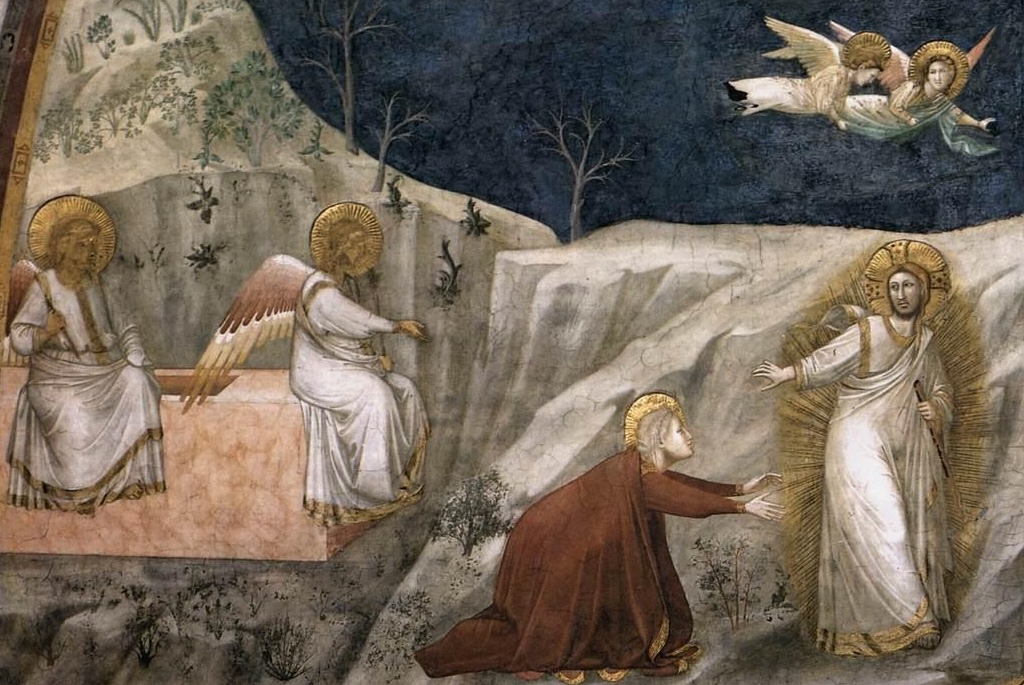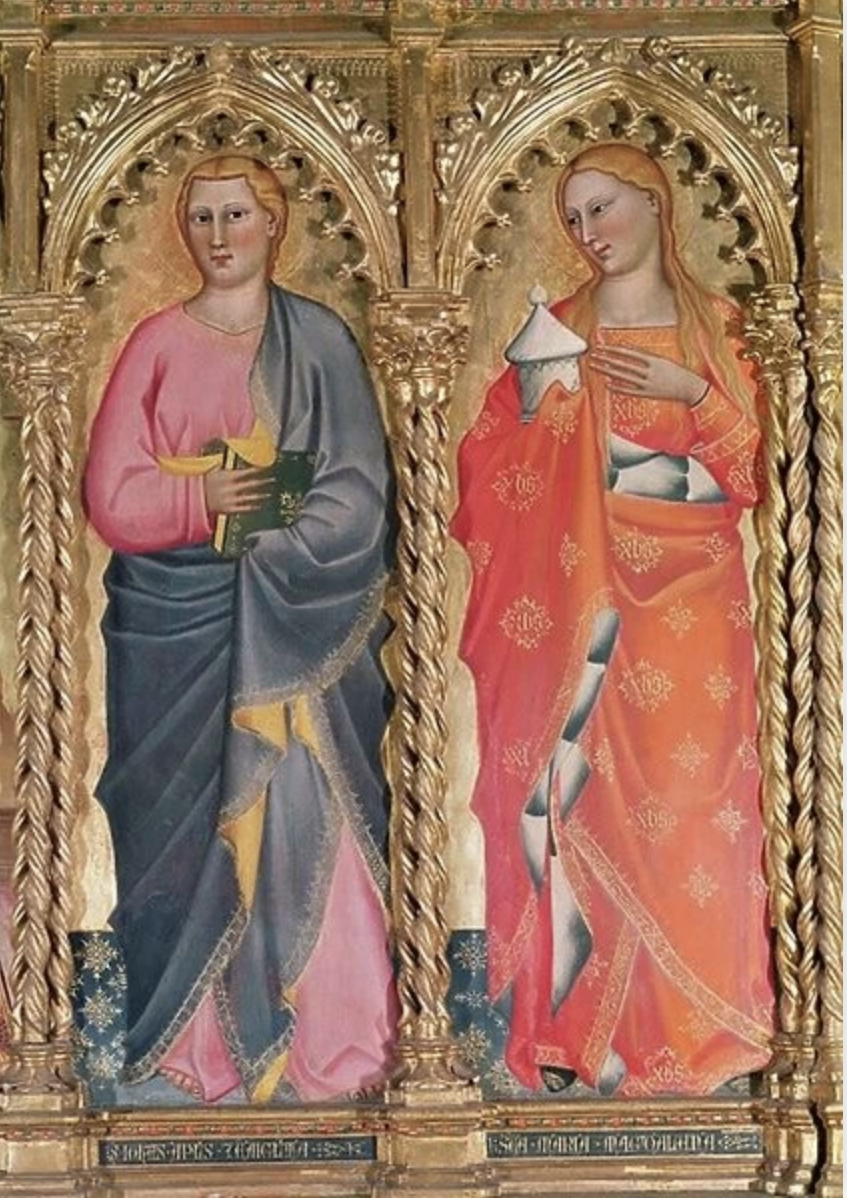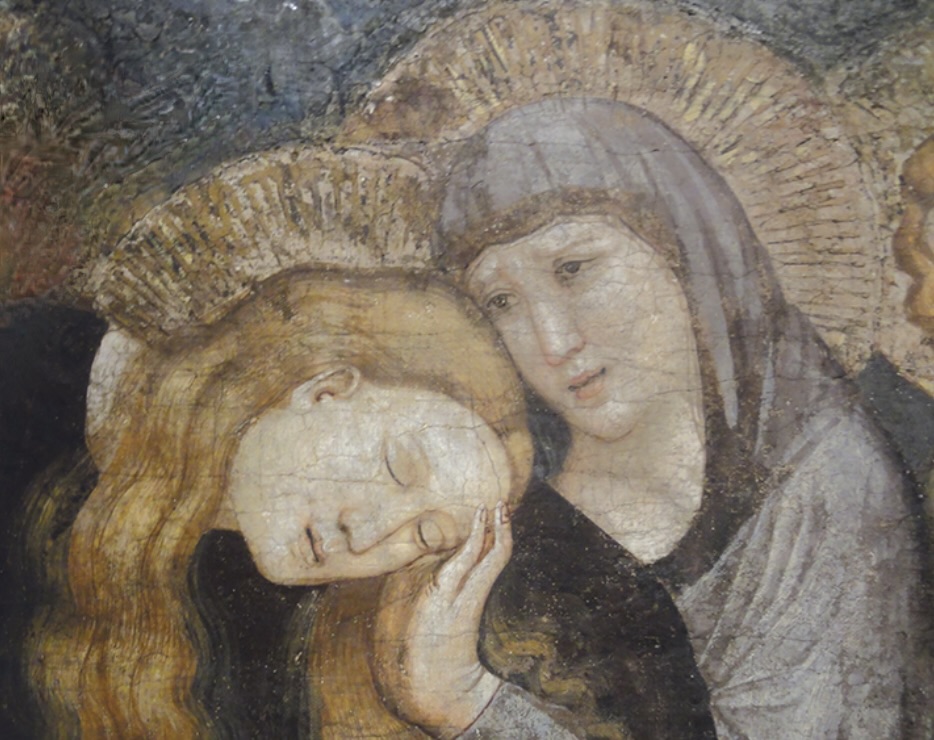
Luke 24:36-53 (Matins)
1 Corinthians 9:2-12
Luke 8:1-3
Towering Faith
And the twelve were with Him, and certain women who had been healed of evil
spirits and infirmities — Mary called Magdalene, out of whom had come seven demons ....
In the Name of the Father and of the Son and of the Holy Ghost. Amen.
Today, we observe St. Mary Magdalene day.
It is a great feast.
In the West she has been granted a feast day in the General Roman Calendar since 1969.
She has been venerated with high esteem in the Eastern Church from the beginning.

The Gospels together with Sacred Tradition
combine to present us with two perfections of discipleship,
one male, the other female:
St. John the Apostle and St. Mary Magdalene, Equal-to-the-Apostles.
They each struggled with imperfection in their youth:
he beset by overweening ambition (Mk 10:35-45)
(you will recall him cornering Jesus with his brother James
pressing Jesus for preferments).
and
she thoroughly possessed by an undisclosed weakness.
They each encounter the Lord of Life, Who heals them.
They respond with an overwhelming gratitude,
devoting themselves to Him
and
loving Him with a love that is unprecedented in Holy Scripture.
At His Crucifixion, they stand together at the foot of the Cross,
alone among the disciples,
not counting the cost,
accompanying the Mother of God and Her kinswoman.
Thereafter,
Mary Magdalene follows the Beloved Disciple and the Most Holy Theotokos
to Ephesus,
where Mary, Mother of God, will fall asleep (we know not when)
and
where Mary, Equal-to-the-Apostles,
will repose.
Two
perfections,
one man and one woman,
presented to us as models.
For emulation goes to the heart of Christian life.
We are to follow (Mt 4:9, Mk 1:7, Lu 9:23, Jn 1:43, Jn 12:26).
We are to deny ourselves (Mt 16:24, Mk 8:34, Lu 9:23).
We are to be servants (Mt 20:26, Mk 9:35, Lu 16:38).
We are to mold our lives
through unending spiritual formation.
And
in so doing,
we eventually fulfill the Image set upon us at birth,
by the grace of God.
We are to follow Him,
and
we are to follow those whom He has set before us.
They are known to us as a pattern of faith by their
right belief,
by their love,
and
by their holiness.
Now, the Holy Gospel According to St. John
is the theological norm for the Orthodox confession of faith,
according to St. Theophan the Recluse.
St. John is the Theologian,
who has definitively set down Christian belief in his Gospel
and
sketched out Christian life in his Letters.
Both he and his writings are to be followed.
I submit that St. Mary Magdalene is his counterpart,
the example-without-equal for women
and
John's constant companion.
Prof. Katherine Jansen
cites St. Jerome, a Father of the Early Church, as attesting marriage between the two
(The Making of the Magdalene (Princeton University Press, 2001)).
He writes that she towered above ordinary people
(noting that
magdala is the Aramaic word for "tower" or "fortress")
much as St. John soared like an eagle above the other Evangelists.
St. Luke tells us that Mary helped to underwrite
Jesus' ministry
"from [her] substance" (Lu 8:3).
So she evidently was that rarity among first-century women
—
financially independent
as
we hear nothing of a husband or kinsmen.
For most Jewish women were forbidden to own property.
(Indeed, they were property.)
It is unlikely, therefore, that she was a Jew at all.
Her attraction to Jesus and her later close friendship
with St. John
both
suggest that
she was
antagonistic to Jews,
a word which denotes
adherents to the hybrid Babylonian religion,
Judah-ism,
which had been
promulgated fiercely by the Maccabees during the preceding century.
It is far more plausible that Mary Magdalene was
a gentile disciple of Jesus,
having more in common,
culturally speaking,
with the physician Luke
than with
Mary and Martha of Bethany.
Women, within Roman culture, occupied a place of influence
as we find attested in Pilate's wife,
who acts as political advisor.
In Rome itself,
some families chose to educate their daughters to the highest degree,
attested by Hydrangea,
daughter of Hortensius.
This young women displayed deep erudition and abundant rhetorical skills
opposing
even so great a rival as
Cicero.
These are attainments of the highest order.
The Synaxarion remembers her in most reverent terms:
|
"Was she the Virgin Esaias spoke of", wondered Satan.
|
That is,
could this paragon,
the most favored daughter of God,
be the sacred vessel through which the Almighty would enter human history?
Accordingly,
he assailed her with seven demons.
Consequently, her early life was spent in constant spiritual warfare.
|
But she valiantly withstood them and never opened the door to any of them.
|
You know,
the Synaxarion
(also called
The Great Synaxaristes of the Orthodox Church)
is not a systematic theology.
It is a collection of traditions.
It is not obliged to sort out contradictions.
The entry on "Mary Magdalene"
also explains that "seven" was a first-century term
denoting "complete" or "thorough"
suggesting that St. Mary Magdalene had a weakness
that had taken thorough hold of her.
For example,
Jesus uses the idiom "seventy time seven" (Mt 18:22) meaning "complete to an extraordinary degree."
Because of the lascivious rumors that continue to swirl around Mary Magdalene
in our own time,
I am obliged to address them.
One of brother priests, from Ireland, saluted me this morning
in my Facebook posting
remembering Mary Magdalene as a fallen woman who had been healed.
Now, I love this man dearly,
but there is no basis to believe such a thing.
But let us reflect on Mary Magdalene as having seven demons.
To scale this,
consider the man with "legion" demons (Mk 5:9) numbering approximately to 5,400.
That is, by comparison whatever it was that might have contended
with Mary Magdalene
it was a relatively mild contest.
And Jesus casts them out undramatically, not appearing in any Gospel narrative,
that is,
done in passing.
What exactly was that sin?
There is not a scintilla of evidence that it had anything to do with sex.
Perhaps
it was the inordinate love of money, which is common enough among the wealthy.
Perhaps it was arrogance or envy or conceit, again common sins found among the upper classes.
Perhaps it was none of these.
We do not know.
Who started these rumors?
They seem to have begun with a sermon written by Pope Gregory I
(sixth century)
in which he conflates
Mary Magdalene,
Mary of Bethany,
and
the prostitute who washed Jesus'
feet ....
without warrant,
without any evidence at all.
This idea appealed to him.
So embarrassed was the Roman Catholic Church over this
notorious lapse in scholarship and judgment,
that Pope Paul VI explicitly delinked Mary Magdalene
from this association in 1969.
Better late than never.
The Orthodox Church has never participated in this lie,
but has faithfully represented her
as "Equal-to-the-Apostles,"
as an absolutely faithful disciple,
as a wealthy patron of the Christian Apostolate,
and
as
the first to proclaim the good news that "Christ is risen!"
Well might we associate St. Mary Magdalene with Easter or Pasha.
She is the first to enunciate this sentence:
"Christos anesti, Kristos voskrese!"
Indeed,
she is the first Apostle .... sent by, whom?
Sent by God Himself!
And to whom?
To the Apostles!
Exalted to say the least!
Jesus said to her, "Do not cling to Me, for I have not yet ascended to My Father;
but go to My brethren and say to them, 'I am ascending to My Father and your Father,
and to My God and your God.'"
(Jn 20:17)
|
Jesus appoints her.
Jesus commissions her.
She had gone out alone to tomb
taking no care for her safety.
For a woman walking alone at night was subject to attack.
Her object was to express devotion to Jesus
—
an
act which might have been deemed treasonous.
Yet not counting the cost she was there.
And for her courage,
for her faithfulness,
and
for her love,
she was crowned with glory:
first to see the stone rolled away,
first to see the Risen Lord,
and
accorded the fellowship of angels:
And she saw two angels in white sitting, one at the head and the other
at the feet, where the body of Jesus had lain. Then they said to her,
"Woman, why are you weeping?"
(Jn 20:12-13)
|

The second one to behold the empty tomb is the friend of her soul, John.
For a few moments they stood
gazing at the empty tomb,
side-by-side,
perhaps hand-in-hand ....
as Peter came huffing and puffing up the path.
These two,
set before us to follow in their exemplary
faithfulness and love:
the Christian ideals of discipleship.
And their footsteps from that empty tomb
were
always and everywhere directed only to the Kingdom of Heaven.
They never stumbled.
They were always filled with the love of God.
The world for them was but a memory.
(The Ruach of the Holy Spirit descends upon us
and
the blessing of rain ....
God's undoubted blessing.)
And
their daily round
(as it should be for us, and is)
together with the Most Holy Mother of God,
was spent in recollection,
in prayer,
and
in doing all such good works that God has given us to walk in.
Some scholars suggest that Mary Magdalene assisted John in writing
what we now call chapters one through twenty
of St. John's Gospel.
Certainly,
such a feat matches the profile we have drawn of an educated
woman of the first century,
perhaps explaining the sophistication of the Gospel's superior use of Greek.
And if two co-authors in this little community, why not three,
including the Venerable Woman for Whom they cared
until Her falling asleep in Ephesus?
I should note that Mary Magdalene was only seven years younger
than Jesus' Mother and her constant companion and caretaker.
At least that is how The Great Synaxaristes of the Orthodox Church
remembers it.
Certainly,
such a holy project would
have been a natural outcome of their close friendship,
which was grounded
in their common depth of devotion,
their love for Jesus,
and
their intimate knowledge of the details of His Life.
The Mother of God,
St. John,
St. Mary Magdalene .... who knew Jesus better than they did?
But such things, inspiring as they are, at the end of the day are imponderables.
It is enough to know that their love of God
shines for the ages
and
undoubtedly stands out for their edification,
that we should mold our lives to their example,
these three:
the Most Holy Mother of God,
St. John the Theologian (our definitive teacher),
and
St. Mary Magdalene, Equal-to-the-Apostles,
crowned with glory always
for her pure, pure, impregnable, towering love.
In the Name of the Father and of the Son and of the Holy Ghost. Amen.


